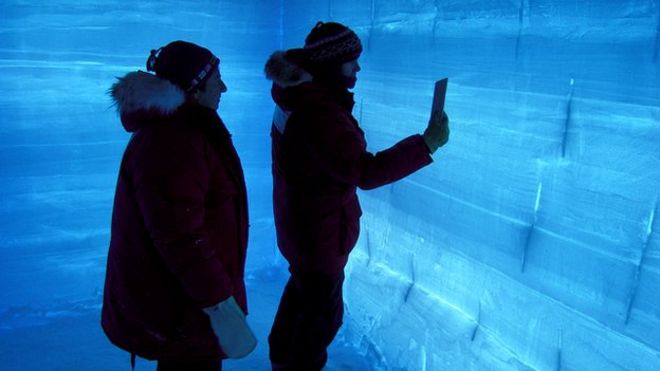| Site menu |
|
 |
| Login form |
|
 |
| Section categories |
|
 |
|
Main » 2015 » May » 06 » Ice cores show 200-year climate lag
00:36 Ice cores show 200-year climate lag |

The Antarctic core provides a comparison with records from Greenland
Scientists have found a 200-year lag time between past climate events at the poles.
The most detailed Antarctic ice core provides the first clear comparison with Greenland records, revealing a link between northern and southern hemisphere climate change.
Scientists found that abrupt and large temperature changes first occurred in Greenland, with the effect delayed about 200 years in the Antarctic.
The study appears in Nature journal.
The paper is the work of almost 80 authors and it is the first time that researchers have been able to pin down the timing of these events during the last Ice Age.
In the 1990s, scientists took ice cores from Greenland that revealed very abrupt and large swings in temperature approximately 20,000 to 60,000 years ago. But it wasn't clear how this influenced global climate change.
The 3,405 metre-long ice core, taken from the centre of West Antarctica, is the longest high resolution ice core. Researchers documented 18 abrupt climate events.
"This record has annual resolution, meaning we can see information about every year going back 30,000 years, and close to that resolution all the way back to 68,000 years ago," explains Eric Steig, professor of Earth and Space Sciences at the University of Washington, who co-wrote the paper.
"Our new results show unambiguously that the Antarctic changes happen after the rapid temperature changes in Greenland. It is a major advance to know that the Earth behaves in this particular way."

Cores contain a record of past temperature swings
The new core also supports the "bipolar seesaw" effect between poles, meaning that when it's warm in Greenland, Antarctica is cooling, and vice versa.
"The fact that temperature changes are opposite at the two poles suggests that there is a redistribution of heat going on between the hemispheres," said Christo Buizert, lead author on the study and a post-doctoral researcher at Oregon State University.
"We still don't know what caused these past shifts, but understanding their timing gives us important clues about the underlying mechanisms."
During large changes in climate in the northern hemisphere, the atmosphere and ocean transfer the heat around the globe.
The 200-year difference in the timing directly points to the ocean, explained Prof Steig. The atmospheric circulation of heat would have shown up in the Antarctic record in a matter of years or decades.
The team has planned further studies to really unpack the annual resolution seen in the core.
Prof Steig concluded: "We've actually been talking about and planning for this ice core for essentially my entire career.
"I remember an old colleague of mine telling me how we should go to this spot in Antarctica and drill an ice core in 1989 when I was beginning graduate school. And we've only really just finished the work about 25 years later." |
|
Category: Science & Technology |
Views: 1038 |
Added by: ValerieTr
| Rating: 0.0/0 |
|
|
| Tags Cloud |
|
 |
| Statistics |
Total online: 13 Guests: 13 Users: 0 |
 |
| Chat window |
|
|
 |
| Calendar |
| « May 2015 » |
| Su |
Mo |
Tu |
We |
Th |
Fr |
Sa |
| | | | | | 1 | 2 | | 3 | 4 | 5 | 6 | 7 | 8 | 9 | | 10 | 11 | 12 | 13 | 14 | 15 | 16 | | 17 | 18 | 19 | 20 | 21 | 22 | 23 | | 24 | 25 | 26 | 27 | 28 | 29 | 30 | | 31 | |
 |
| Entries archive |
|
 |
|












